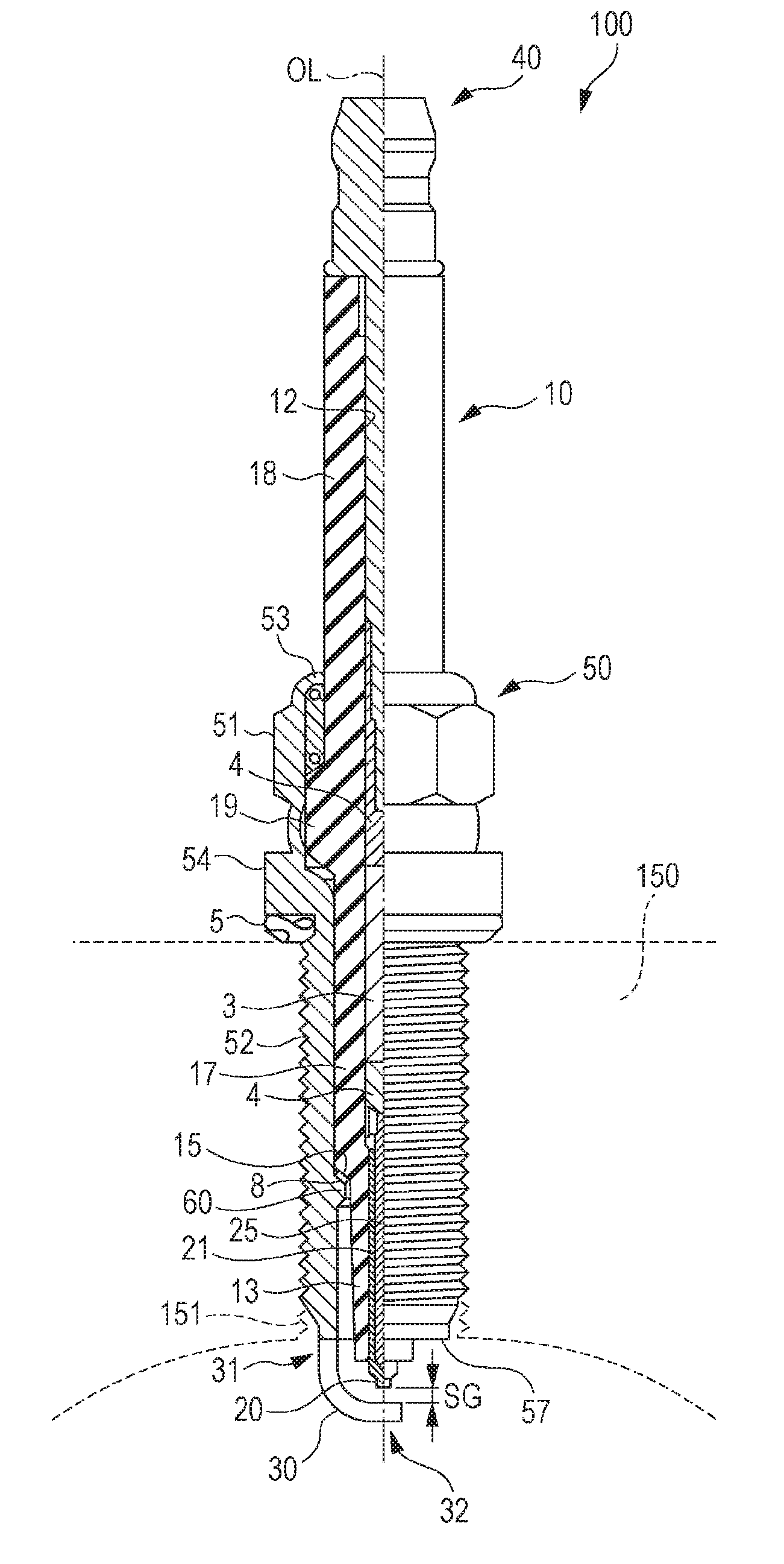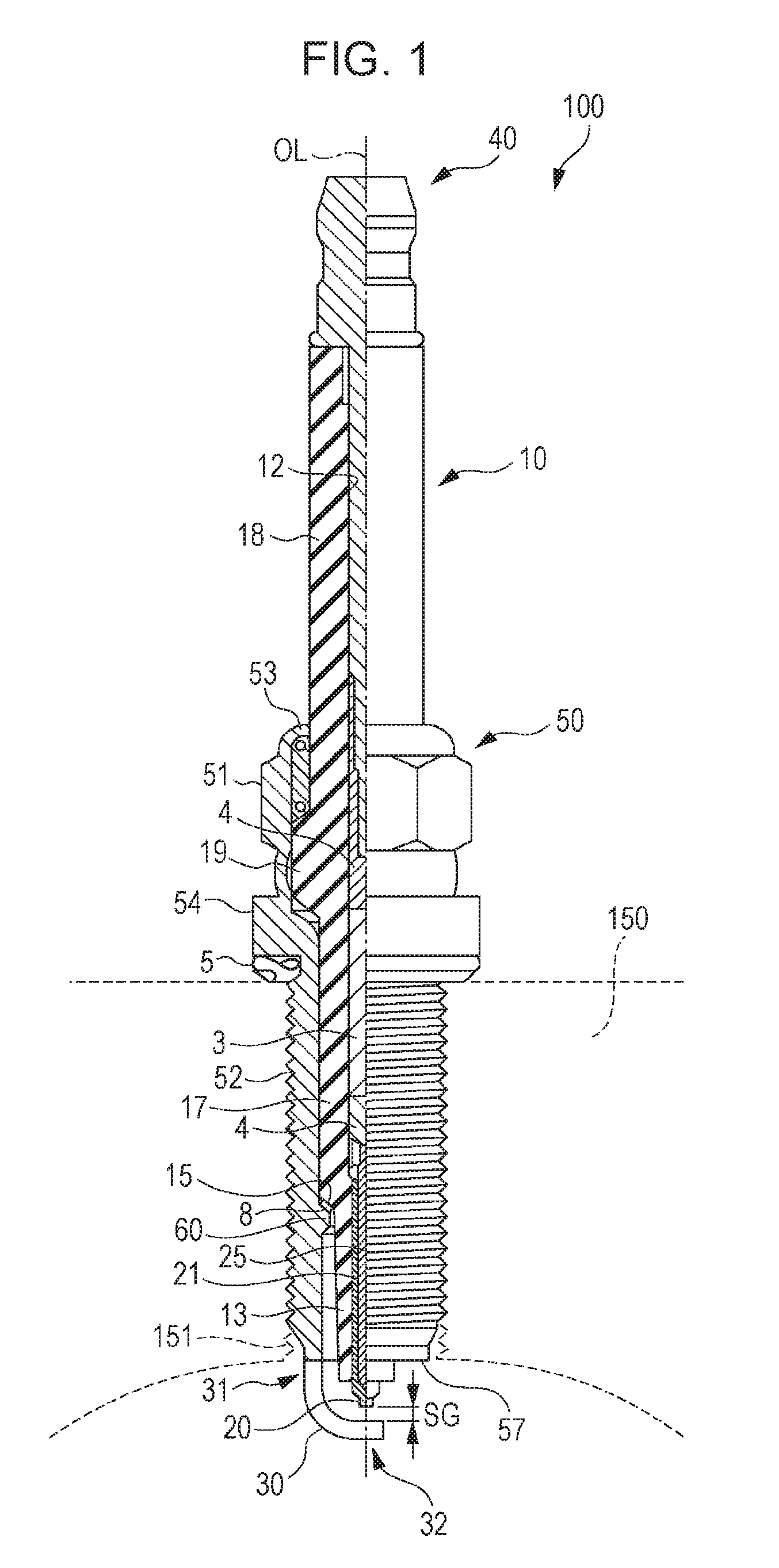Ignition plug
a plug and plug-in technology, applied in the direction of spark plugs, spark plugs, basic electric elements, etc., can solve the problems of sway of sparks, misfiring risk, spark size, etc., to prevent or reduce erosion and uneven wear of ground electrodes, prevent or reduce separation between ground electrodes and noble metal chips, and prevent or reduce erosion of ground electrodes.
- Summary
- Abstract
- Description
- Claims
- Application Information
AI Technical Summary
Benefits of technology
Problems solved by technology
Method used
Image
Examples
experiment 1
[0046] In Experiment 1, the base material layer 301 was made of material 1 and the erosion-resistant layer 302 was made of materials 2 to 5. As a comparative example, the amount of erosion caused when a ground electrode including only the base material layer 301 was used was determined to be 2.8 mm3. Table 3 shows the result of Experiment 1. In Table 3, “BR” indicates that breakage of the ground electrode 30 occurred.
TABLE 3BaseMaterialErosion-Material 1 Thickness 1.3 mmResistantMaterial 2Material 3Material 4Material 5MaterialAmount of Erosion (mm3)Thickness0.12.72.52.32.2t1 of0.22.71.81.61.5Erosion-0.42.71.71.51.4Resistant0.62.71.71.51.4Layer (mm)0.82.7BRBRBR1.02.7BRBRBR
[0047]When the erosion-resistant layer 302 was made of material 2, the amount of erosion of the entire body of the ground electrode 30 was 2.7 mm3 irrespective of the thickness t1. When the erosion-resistant layer 302 was made of material 3, the amount of erosion of the entire body of the ground electrode 30 was 1.8...
experiment 2
[0048] In Experiment 2, the base material layer 301 was made of material 2 and the erosion-resistant layer 302 was made of materials 3 to 5. As a comparative example, the amount of erosion caused when a ground electrode including only the base material layer 301 was used was determined to be 2.7 mm3. Table 4 shows the result of Experiment 2. In Table 4, “BR” indicates that breakage of the ground electrode 30 occurred.
TABLE 4Base MaterialMaterial 2 Thickness 1.3 mmErosion-ResistantMaterial 3Material 4Material 5MaterialAmount of Erosion (mm3)Thickness t1 of0.12.42.32.2Erosion-Resistant0.21.81.51.5Layer (mm)0.41.71.51.40.61.61.51.40.8BRBRBR1.0BRBRBR
[0049]When the erosion-resistant layer 302 was made of material 3, the amount of erosion of the entire body of the ground electrode 30 was 1.8 mm3 or less for the thickness t1 of 0.2 mm or more and 0.6 mm or less. When the thickness of the erosion-resistant layer 302 was 0.8 mm or more, that is, when the thickness of the base material layer ...
experiment 3
[0052]performed by using material 3 as the material of the base material layer 301. As a comparative example, a ground electrode 30 including only the base material layer 301 was tested. As a result, physical breakage of the ground electrode 30 occurred due to vibration. This is probably because the tensile strength of material 3 was 480 (Mpa), as shown in Table 2, and durability against a vibration of 30 G and a temperature of 800° C. was not sufficient. Therefore, experiments with the base material layer 301 made of materials 3 to 5 and the erosion-resistant layer 302 made of materials 4 and 5 could not be performed.
[0053]In the first study, the ground electrode 30 in which the erosion-resistant layer 302 was formed over the entire region of the inner surface 30a was used. Alternatively, a ground electrode 30 illustrated in FIG. 4 may instead be used. This ground electrode 30 has a two-layer structure including, in addition to the base material layer 301, the erosion-resistant lay...
PUM
 Login to View More
Login to View More Abstract
Description
Claims
Application Information
 Login to View More
Login to View More - R&D
- Intellectual Property
- Life Sciences
- Materials
- Tech Scout
- Unparalleled Data Quality
- Higher Quality Content
- 60% Fewer Hallucinations
Browse by: Latest US Patents, China's latest patents, Technical Efficacy Thesaurus, Application Domain, Technology Topic, Popular Technical Reports.
© 2025 PatSnap. All rights reserved.Legal|Privacy policy|Modern Slavery Act Transparency Statement|Sitemap|About US| Contact US: help@patsnap.com



